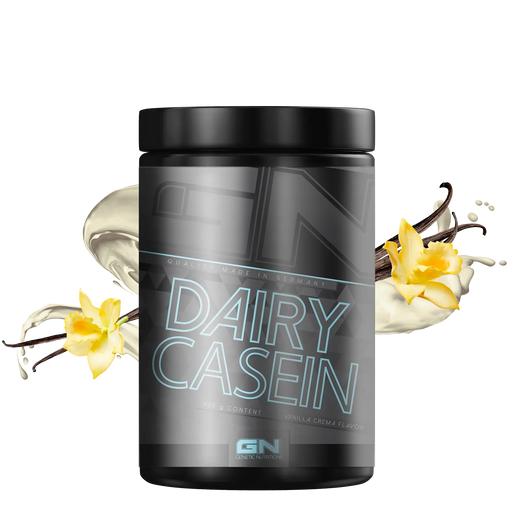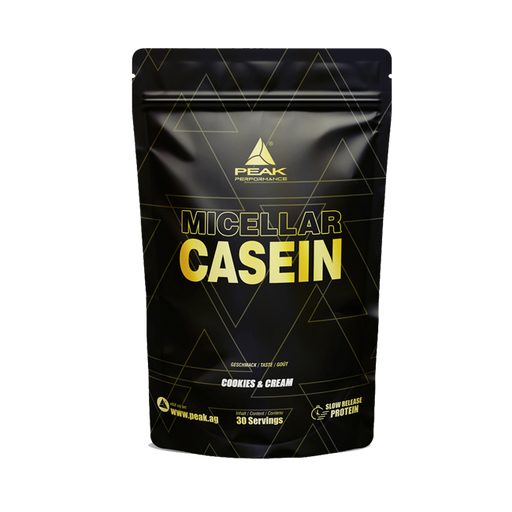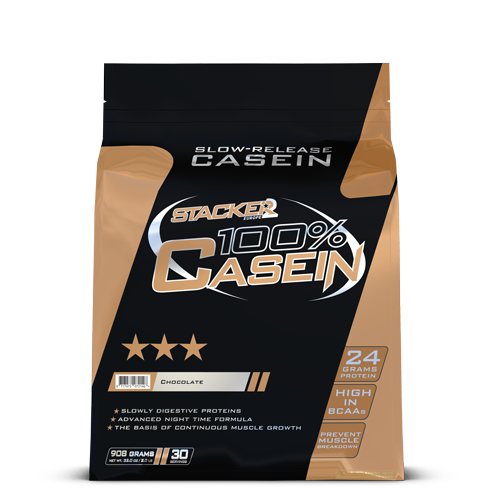Casein Protein
Filter
-
 Ausverkauft
Original-Preis €28,90 - Original-Preis €28,90Original-Preis €28,90€28,90€28,90 - €28,90Aktueller Preis €28,90|/
Ausverkauft
Original-Preis €28,90 - Original-Preis €28,90Original-Preis €28,90€28,90€28,90 - €28,90Aktueller Preis €28,90|/100% Dairy Casein · 900g
GN Laboratories15 reviewsCasein ist neben Whey das wohl am häufigsten genutzte Protein-Pulver. Viele Sportler ziehen Casein je nach Situation einem gewöhnlichen Whey Shake ...
Vollständige Details anzeigenOriginal-Preis €28,90 - Original-Preis €28,90Original-Preis €28,90€28,90€28,90 - €28,90Aktueller Preis €28,90|/Ausverkauft -
 Jetzt 0% sparen
Jetzt % sparen
Original-Preis €34,90 - Original-Preis €34,90Original-Preis €34,90€34,90€34,90 - €34,90Aktueller Preis €34,90|/
Jetzt 0% sparen
Jetzt % sparen
Original-Preis €34,90 - Original-Preis €34,90Original-Preis €34,90€34,90€34,90 - €34,90Aktueller Preis €34,90|/Micellar Casein · 900g
PEAK1 reviewCremiges & leckeres Micellares Casein Protein mit Langzeitversorgung Enthält 80 %* erstklassiges Milchprotein. Unterstützt hauptsächlich den ...
Vollständige Details anzeigenOriginal-Preis €34,90 - Original-Preis €34,90Original-Preis €34,90€34,90€34,90 - €34,90Aktueller Preis €34,90|/Jetzt 0% sparen Jetzt % sparen -
 Jetzt 0% sparen
Jetzt % sparen
Original-Preis €34,90 - Original-Preis €34,90Original-Preis €34,90€34,90€34,90 - €34,90Aktueller Preis €34,90|/
Jetzt 0% sparen
Jetzt % sparen
Original-Preis €34,90 - Original-Preis €34,90Original-Preis €34,90€34,90€34,90 - €34,90Aktueller Preis €34,90|/100% Casein · 908g
Stacker 22 reviewsEffiziente Proteinversorgung über Nacht mit 100% Casein. Verhindert Muskelabbau und unterstützt kontinuierliches Muskelwachstum. 24 Gramm hochwert...
Vollständige Details anzeigenOriginal-Preis €34,90 - Original-Preis €34,90Original-Preis €34,90€34,90€34,90 - €34,90Aktueller Preis €34,90|/Jetzt 0% sparen Jetzt % sparen
Casein (vom lateinischen caseus = Käse) ist ein grobflockig gerinnendes Protein (Eiweiß) und die wichtigste Eiweißart der Milch (80 % des Gesamteiweißgehaltes, 3 % der Milch). Es ist der Hauptbestandteil von Quark und Käse und kann durch Milchgerinnung mittels Erhitzung, durch Zugabe von Lab oder mit Hilfe von Säuren oder als Calcium-Salz ausgefällt werden. Durch Filtration oder Zentrifugation wird dann das Casein abgetrennt. Durch die Erhitzung, Säurezugabe oder verstärkt durch Zugabe des Enzyms Pepsin findet ein Teilabbau des Kaseins statt, was Casein aus Käse und Quark leichter verdaulich macht als das in der Rohmilch.
In einem Liter Vollmilch sind 3,2 bis 3,5 Prozent Casein enthalten. Um einen Tagesbedarf an lebensnotwendigen Aminosäuren zu decken, bedarf es nur einen Liter dieser Milch. Die Eiweiße der Milch können vom Körper fast vollständig verwertet werden.
Casein ist also ein langsam verdauliches Milchprotein, das eben wegen seiner langen Verweildauer im Verdauungsapparat häufig als Supplement verwendet wird. Es setzt seine Aminosäuren langsam frei, weshalb es von Sportlern gerne vor dem Zubettgehen verwendet wird, um die Regeneration zu unterstützen und einen Muskelabbau während des Schlafes zu reduzieren. Casein stellt so etwas wie die „Königsklasse“ der langsam verdaulichen Proteine dar, da es nach dem Verzehr für bis zu 8 Stunden kontinuierlich Aminosäuren liefert, während schnell verdauliches Whey Protein lediglich für eine Dauer von 3 Stunden Aminosäuren in den Blutkreislauf freisetzt.
Es findet Verwendung als Rohstoff für verschiedene Verarbeitungszwecke. So als Lebensmittel, jedoch auch als Bindemittel für Farben, als Leim oder auch als Fotolack in der Ätztechnik. Vom Ende des 19. Jahrhunderts bis in die 1930er Jahre Ausgangsmaterial für den "Kunststoff" Galalith, der u.a. für Knöpfe und Schmuck, aber auch zu Isolationszwecken für elektrische Anlagen verwendet wurde.
Mehrere Studien haben gezeigt, dass Casein den Muskelkaufbau anregt und eine Vielzahl weiterer Gesundheitsvorzüge besitzt. Wie andere tierische Proteine stellt auch Casein eine vollständige Proteinquelle dar, was bedeutet, dass es alle essentiellen Aminosäuren liefert, die der Körper für Wachstum und Reparatur benötigt (1). Zusätzlich hierzu enthält Casein unterschiedliche einzigartige und bioaktive Verbindungen, die eine Reihe von Gesundheitsvorzügen besitzen (2, 3).
Die beiden primären Formen von Casein sind:
- Micellar Casein: Dies ist die beliebteste Form, die langsam verdaulich ist.
- Casein Hydrolysat: Diese Form ist enzymatisch “vorverdaut” und wird schnell vom Körper absorbiert.
Im Durchschnitt enthält ein Standard 33 Gramm Messlöffel eines Casein Proteinpulvers 24 Gramm Protein, 3 Gramm Kohlenhydrate und 1 Gramm Fett (4). Zusätzlich hierzu können unterschiedliche Mikronährstoffe wie Kalzium enthalten sein. Die exakte Nährstoffkomposition variiert jedoch von Hersteller zu Hersteller.
Casein ist sehr viel langsamer verdaulich als Wheyprotein und stellt ein antikataboles Protein dar Casein ist aufgrund seiner langsamen Absorptionsrate im Darm auch als Protein mit “zeitversetzter Freisetzung” bekannt. Dies bedeutet, dass es die Zellen des Körpers über einen langen Zeitraum mit Aminosäuren versorgen kann, wobei die Blutspiegel an Aminosäuren aufgrund der langsameren Freisetzung niedriger als bei schnell verdaulichem Wheyprotein ausfallen.
Casein kann dem Körper selbst zu den Zeiten helfen Protein zu synthetisieren, während der der Körper normalerweise Muskelprotein abbauen würde, um sich mit benötigten Aminosäuren zu versorgen. Ein Beispiel für eine solche Zeit wäre z.B. die nächtliche Fastenphase, während der kein Protein über die Nahrung zugeführt wird (5, 6). Aus diesem Grund wird Casein auch als antikataboles Protein bezeichnet, das dabei hilft, einen Muskelabbau zu reduzieren (7).
Eine Studie testete die Verdauungsgeschwindigkeit, indem sie Probanden jeweils einen Casein oder einen Wheyproteinshake konsumieren ließ. Die Wissenschaftler kontrollierten den Blutaminosäuregehalt – und insbesondere die Spiegel der Aminosäure Leucin – über 7 Stunden nach Konsum des Proteinshakes (8).
Sie konnten hierbei beim Wheyprotein Shake aufgrund der schnelleren Verdauung einen schnelleren und stärkeren Anstieg der Blutaminosäurespiegel beobachten. Bei Casein fiel der Anstieg der Blutaminosäurespiegel schwächer aus, blieb hierfür aber über einen längeren Zeitraum konsistent. Sie fanden auch heraus, dass die zirkulierenden Spiegel von Leucin bei der Wheyprotein Gruppe um 25% stärker anstiegen, was auf eine schnellere Verdauung hindeutet (8).
Dies bedeutet, dass bei der Casein Gruppe die Gesamtmenge an Protein, die zum Zweck der Energiegewinnung über einen Zeitraum von 7 Stunden verbrannt wurde, niedriger ausfiel. Dies wiederum bedeutet eine bessere Netto Proteinbilanz – ein Schlüsselfaktor für Muskelwachstum und Muskelerhaltung (9).
Zusammenfassung: Casein ist ein antikataboles Protein. Es reduziert den Proteinabbau im Körper aufgrund seiner langsamen Verdauungsrate und einer anhaltenden Versorgung der Muskelzellen mit Aminosäuren.
Casein Protein ist für das Muskelwachstum sehr effektiv
Bodybuilder und Sportler verwenden Casein seit Jahrzehnten. Wie andere tierische Proteine enthält auch Casein alle essentiellen Aminosäuren, die der Körper nicht selbst herstellen kann. Noch wichtiger ist, dass es große Mengen der Aminosäure Leucin liefert, welche die Proteinsynthese initiiert (9, 10, 11).
Wenn man nur eine niedrige oder moderate Menge an Protein konsumiert, könnte Casein dabei helfen, das Muskelwachstum ganz einfach nur über eine Erhöhung der Proteinzufuhr zu steigern (12). Eine Studie verglich Probanden, die Casein zu sich nahmen mit zwei anderen Gruppen, von denen eine Wheyprotein konsumierte und die andere kein zusätzliches Protein zu sich nahm. Am Ende der Studie fanden die Wissenschaftler heraus, dass die Casein Gruppe im Vergleich zur Placebogruppe doppelt so viel Muskelmasse aufgebaut und dreimal so viel Fett verloren hatte. Die Casein Gruppe hatte außerdem mehr Fett als die Wheyprotein Gruppe verloren (13). Studien zufolge steigt die Proteinoxidation nach dem Verzehr von schnell verdaulichem Protein wie Whey Protein sehr viel stärker als nach dem Verzehr von Casein an. Mit anderen Worten ausgedrückt verbrennt der Körper nach dem Verzehr von Whey Protein eine größere Menge des zugeführten Proteins zum Zweck der Energieversorgung als nach dem Verzehr von Casein.
Casein könnte auf lange Sicht auch durch eine Reduzierung des Proteinabbaus die Gesamtmuskelmasse steigern. Dieser Prozess des Proteinabbaus findet auf täglicher Basis statt, wenn der Körper niedrige Energie- oder Aminosäurespiegel aufweist. Der Proteinabbau wird darüber hinaus während des Trainings oder einer Gewichtsabbauphase beschleunigt (7, 8, 14).
Aus diesem Grund wird Casein oft als letzte Mahlzeit vor dem Zubettgehen konsumiert, um den Proteinabbau zu verhindern, der nachts zustande kommen kann, weil man während des Schlafes über einen relativ langen Zeitraum kein Protein zu sich nimmt.
Im Rahmen einer Studie half ein Casein Proteinshake vor dem Zubettgehen Kraftsportlern dabei, ihre Typ-2 Muskelfaserquerschnittsfläche um 8,4 cm2 zu erhöhen, während die Erhöhung bei der Placebogruppe bei lediglich 4,8 cm2 lag (15). Es konnte weiterhin beobachtet werden, dass die Casein Gruppe ihre Kraft um 20% stärker als die Placebogruppe steigern konnte.
Zusammenfassung: Es konnte wiederholt gezeigt werden, dass Casein in Kombination mit einem Widerstandstraining Kraft und Muskelmasse steigern kann. Es könnte zusätzlich auch beim Fettabbau helfen.
Casein könnte dabei helfen, die Schlafqualität zu verbessern
Einige Fitnessexperten behaupten, dass Casein die Schlafqualität verbessern kann. Eine Theorie besagt, dass das in Casein enthaltene Tryptophan hierfür verantwortlich sein könnte. Tryptophan ist zwar eine Aminosäure, die bei der Regulierung des Schlafes hilft, aber Casein enthält lediglich 1,1 % Tryptophan. Es ist also gut möglich, dass Tryptophan mit dieser Wirkung von Casein nur am Rande zu tun hat.
Stattdessen könnte die den Schlaf betreffende Wirkung von Casein damit zusammenhängen, dass Casein ein Peptid namens AlphaS-1 Peptid enthält. Dieses Peptid ist dafür bekannt, dass es Unruhe, Angst und Stress reduziert.
Eine mit Ratten, die unter chronischem Stress litten, durchgeführte Studie fand heraus, dass das AlphaS-1 Peptid, das sich in Casein wiederfindet, dabei half, den Schlaf zu verbessern (28).
Casein kann beim Gewichtsabbau helfen
Eine holländische Studie kam zu dem Ergebnis, dass Casein Protein dabei helfen könnte, die Stoffwechselrate während des Schlafes zu erhöhen. Diese Studie zeigte außerdem eine massive Steigerung der Sättigung um 33%, was den Probanden dabei half, insgesamt weniger zu essen (29). Eine andere Studie aus dem Jahr 2004 zeigte, dass Casein Männern dabei helfen konnte, ihren Fettabbau über einen Zeitraum von 12 Wochen zu verdoppeln (8% im Vergleich zu 4% bei der Placebogruppe (13).
Während einer kalorienreduzierten Diät benötigt Ihr Körper zur Aufrechterhaltung der Muskelmasse mehr Protein als während einer Aufbauphase oder einer Erhaltungsphase. Viele Diätende glauben fälschlicherweise, dass Wheyprotein aufgrund seiner höheren biologischen Wertigkeit während einer Diät die beste Wahl darstellt, doch dies ist nicht wirklich der Fall.
Die aus der langsamen Verdauung resultierende lange anhaltende Aminosäurefreisetzung verleiht Casein eine deutlich ausgeprägte antikatabole Wirkung, die Ihre Muskeln besser vor einem Abbau von Muskelmasse als die anabole Wirkung von Whey Protein schützen kann. Zahlreiche Studien konnten zeigen, dass Probanden, die während einer Diät Casein als primäre Proteinquelle verwendeten, deutlich weniger Muskelmasse als Probanden verloren, die dieselbe Diät mit einer entsprechenden Menge an Whey Protein durchführten. Dies hängt neben der antikatabolen Wirkung von Casein auch mit der höheren Effizienz dieser Proteinquelle zusammen.
Casein könnte weitere eindrucksvolle Gesundheitsvorzüge besitzen
Einige Studien deuten darauf hin, dass Casein eine Reihe weiterer Gesundheitsvorzüge besitzen könnte:
- Antibakterielle Wirkungen und Anregung des Immunsystems: Einige Studien legen nahe, dass Casein antibakterielle Wirkungen besitzen könnte und die Immunfunktion verbessern könnte (2, 16).
- Blutdruck: Es gibt Hinweise darauf, dass Casein Peptide den Blutdruck senken und Bluthochdruck verhindern könnten (16).
- Triglyzeridspiegel: Eine mit 10 übergewichtigen Probanden durchgeführte Studie fand heraus, dass Casein die Triglyzeridspiegel nach einer Mahlzeit um 22% senken konnte (17).
- Antioxidative Wirkungen: Einige der in Casein Protein enthaltenen Peptide besitzen antioxidative Wirkungen und können freie Radikale bekämpfen (2, 18, 19).
- Förderung der Darmgesundheit: Im Rahmen einer Studie untersuchten australische Wissenschaftler die Gesundheitsvorzüge unterschiedlicher Proteine und fanden heraus, das Milchproteine wie Casein die Gesundheit des Darms stärker als Fleisch oder Sojaproteine fördern (30).
- Schutz der Zähne: Eine britischen Studie zufolge könnte Casein die Zähne schützen, da es das Potential aufweist, die Auswirkungen einer Erosion des Zahnschmelzes zu reduzieren oder zu verhindern (31).
Verwendung im Bereich des Sports
Die biologische Wertigkeit von Casein liegt zwischen 71 und 74, also deutlich unter der von Lactalbumin(Whey). Dafür weist es aber einige für Kraftsportler recht interessante Eigenschaften auf:
- Im Magen-Darm-Trakt wirkt Casein zu einer Art Gel umgeformt, was die Magenentleerung verzögert. So wird zum einen die Kontaktzeit im Darm verlängert, was die Aminosäureresoption verbessert.
- Andererseits kommt es zu einem geringerem und gleichmäßigen Blutzuckeranstieg, wenn mit Casein auch Kohlenhydrate aufgenommen werden. Auf diese Weise werden Heißhungerattacken vermieden und der Fettansatz durch Kohlenhydrate verringert. Deshalb eignet sich Casein gut für eine Diät. Hinzu kommt, dass im Gegensatz zum schnellverdaulichen Lactalbumin (Whey), bei dem die Aminosäuren recht früh im Blut nachweisbar sind, bei Casein der Aminosäure-Einstrom ins Blut zwar verzögert, aber dafür bis zu 8 Stunden nachweisbar ist. So bietet sich Casein als antikataboles Protein vor dem Schlafengehen und ca. 2 Stunden vor dem Training an.
- Casein besitzt einen Glutamingehalt von ca. 20%, höher als der aller anderen Proteinquellen.
Besitzt Casein irgendwelche schädlichen Nebenwirkungen?
Der Mythos, dass eine hohe Proteinzufuhr schlecht für die Gesundheit ist, wurde inzwischen oft genug widerlegt. Direkte Studien und Studienreviews haben hervorgehoben, dass eine hohe Proteinzufuhr bei gesunden Menschen keine negativen Auswirkungen besitzt.
Die einzige Ausnahme stellen Menschen mit bestehenden Erkrankungen von Nieren oder Leber dar, die ihren Proteinkonsum begrenzen sollten (20, 21, 22).
Bei einem Konsum von 1 bis 2 Messlöffeln Casein Protein pro Tag ist es höchst unwahrscheinlich, dass irgendwelche spürbaren – geschweige denn ernsthaften – Nebenwirkungen auftreten. Eine Ausnahme hiervon können Menschen mit einer Milchallergie oder einer Laktoseintoleranz darstellen. Menschen, die auf Milchprotein allergisch reagieren, sollten auf Casein verzichten, während Menschen, die unter einer Laktoseintoleranz die Verträglichkeit mit einer geringen Menge testen und diese Menge langsam erhöhen sollten. An dieser Stelle sei erwähnt, dass unterschiedliche Casein Produkte unterschiedliche Restmengen an Laktose enthalten können.
Andere Menschen können auf Casein mit Blähungen oder andere Verdauungsbeschwerden reagieren, was jedoch sehr stark von der individuellen Verträglichkeit abhängig ist.
Die A1 vs. A2 Kontroverse
Unterschiedliche Arten von Kühen produzieren geringfügig unterschiedliche Casein Proteine. Eines der Proteine in Casein, welches als Beta-Casein bezeichnet wird, existiert in unterschiedlichen Formen. Die meiste Kuhmilch enthält eine Mischung von A1 und A2 Beta-Casein, während die Milch bestimmter Rassen von Kühen nur A1 Beta-Casein enthalten.
Einige Observationsstudien haben A1 Beta-Casein mit Gesundheitsproblemen wie Typ 2 Diabetes und Herzkrankheiten in Verbindung gebracht (23, 24, 25). Observationsstudien sind jedoch alles andere als schlüssig und heben lediglich Verbindungen hervor, was im Bereich der Ernährung nicht besonders verlässlich ist, da diese Studien keine kausalen Verbindungen feststellen können (26, 27) Die Forschung und die Debatte bezüglich A1 und A2 Beta-Casein geht weiter, aber im Augenblick ist dies noch kein Thema, über das man sich Gedanken machen muss.
Wie sollte man mit Casein supplementieren, um dessen Vorzüge zu maximieren?
Casein Proteinpulver ist eine qualitativ hochwertige Proteinquelle, die gleichzeitig auch sehr bequem ist. Wenn es um die Proteinzufuhr vor dem Training geht, macht es mehr Sinn, ein schneller verdauliches Protein wie Casein Hydrolysat oder gleich Wheyprotein zu verwenden.
Die meisten Menschen verwenden Casein vor dem Zubettgehen. Man könnte z.B. 1 bis 2 Messlöffel Casein Protein mit Wasser gemischt zu sich nehmen. Diese Mischung kann man einfach in einem Shaker oder Mixer zu einem Proteinshake anmischen. Alternativ kann man das Casein Pulver auch in eine Schüssel geben und mit Wasser anrühren, bis es eine puddingartige Konsistenz bekommt und es anschließend für 5 Minuten in den Gefrierschrank stellen.
Abgesehen hiervon kann man reichlich Casein in Form von natürlichen Proteinquellen zu sich nehmen. Milch, Hüttenkäse, Quark, Joghurt und Käse enthalten große Mengen an Casein.
Fazit
Kasein ist ein langsam verdauliches Protein, das dem Muskelwachstum einen Schub geben kann und die Regeneration nach dem Training unterstützen kann. Casein kann die Gesundheit verbessern und gleichzeitig Deine tägliche Proteinzufuhr steigern. Dies ist ein wichtiger Faktor für Muskelwachstum und Gewichtsabbau.
Man sollte versuchen 1 bis 2 Messlöffel Casein Proteinpulver vor dem Zubettgehen zu sich nehmen, um die Regeneration zu verbessern und den Proteinabbau zu reduzieren. Am Ende des Tages ist Casein eine stark unterbewertete qualitativ hochwertige Proteinquelle, die niemanden enttäuschen wird, der sie ausprobiert.
Referenzen:
- https://www.ncbi.nlm.nih.gov/pmc/articles/PMC2039733/
- https://www.ncbi.nlm.nih.gov/pmc/articles/PMC4992109/
- https://www.ncbi.nlm.nih.gov/pubmed/12769739
- http://nutritiondata.self.com/facts/custom/1408590/2
- https://www.ncbi.nlm.nih.gov/pubmed/12730415
- https://www.ncbi.nlm.nih.gov/pubmed/11158939
- https://www.ncbi.nlm.nih.gov/pubmed/22330017
- https://www.ncbi.nlm.nih.gov/pubmed/9405716
- https://www.ncbi.nlm.nih.gov/pubmed/20368372
- https://www.ncbi.nlm.nih.gov/pubmed/1280254
- https://www.ncbi.nlm.nih.gov/pubmed/21092368
- https://www.ncbi.nlm.nih.gov/pubmed/17908291
- https://www.ncbi.nlm.nih.gov/pubmed/10838463
- https://www.ncbi.nlm.nih.gov/pubmed/3356636
- http://jn.nutrition.org/content/early/2015/04/29/jn.114.208371
- https://www.ncbi.nlm.nih.gov/pubmed/12769742
- https://www.ncbi.nlm.nih.gov/pubmed/26491119
- https://www.ncbi.nlm.nih.gov/pubmed/11170591
- https://www.ncbi.nlm.nih.gov/pubmed/10719575
- https://www.ncbi.nlm.nih.gov/pmc/articles/PMC2129142/
- https://www.ncbi.nlm.nih.gov/pubmed/1263907
- https://www.ncbi.nlm.nih.gov/pmc/articles/PMC1262767/
- https://www.ncbi.nlm.nih.gov/pubmed/16407643
- https://www.ncbi.nlm.nih.gov/pubmed/11425301
- https://www.ncbi.nlm.nih.gov/pubmed/15453478
- https://www.ncbi.nlm.nih.gov/pubmed/10096780
- https://www.ncbi.nlm.nih.gov/pubmed/16441926
- https://www.ncbi.nlm.nih.gov/pubmed/16303212
- https://academic.oup.com/ajcn/article/89/3/831/4596720
- https://www.ncbi.nlm.nih.gov/pmc/articles/PMC5149046/
- https://www.ncbi.nlm.nih.gov/pubmed/21160185



